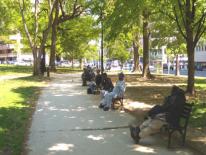
The Vision
Creating a diverse and well maintained world class urban park system that includes federal reservations as well as new urban parks
Center City Parks - The Challenge
One of the key challenges noted in the “Center City Action Agenda” (2008) in developing our emerging center city neighborhoods - such as NoMa and Mount Vernon Triangle - is a “…distinct lack of public spaces and key infrastructure that can attract prime tenants ... and make high density living green and appealing”.
Chief among the missing elements are neighborhood parks and open spaces - key amenities in attracting and maintaining a stable and diverse residential population. Downtown resident and neighborhood groups concerns - voiced over the last couple of years - about the lack of neighborhood park space and parks maintained and programmed with neighborhood-serving amenities, including amenities for children support this reality. The northeast portion of Center City - specifically Mount Vernon Triangle, NoMa, and Northwest One neighborhoods - have the capacity to grow by 23,000 residents over the next decade. Ensuring that these emerging areas become great neighborhoods that are competitive in retaining and attracting residents and families requires investment in the public amenities and open spaces typically found in competing areas in our region.
The obstacles to improving the Center City park system are many, there is a lack of publically-owned land to create parks in emerging neighborhoods, the high cost of real estate in these areas is a barrier to acquiring land, and many existing parks need significant improvement to realize their full potential as urban parks that adequately serve resident needs. This problem requires solutions based on innovative approaches to “built out” urban areas. Other cities as well as emerging Center City neighborhoods in DC, specifically Capitol Riverfront and Poplar Point, offer instructive models for successfully incorporating new major neighborhood parks. However, a lack of budgeting or planning for the improvement to existing -¬- or acquisition of new -- parks in the northeast portion of Center City is a barrier to employing these models.
Goals
- Clearly document Center City park and open space issues to inform the community’s shared understanding the issues and problems.
- Provide information and data to federal partners on Center City resident needs and desires to inform park planning and design.
- Identify a wide diversity of urban park types to expand our shared knowledge of creative solutions to open space needs.
- Communicate new options and strategies for management, funding, and programming of open space to partners and stakeholders
- Recommend changes to policies and regulations to improve how parks are governed
Project Tasks
- Conduct a Demographic Analysis of the current and projected residential and worker populations in Center City to develop an understanding of user needs and demands
- Analyze the Open Space Level of Service to understand where the current gaps in parks and open space programming and facilities
- Develop Programming and Design Recommendations for existing Downtown parks and open spaces to increase their amenities and usability
- Research Case Studies and Best Practices for innovative strategies for site constricted urban conditions and funding methods used to construct, acquire maintain, program, park improvements and sites
- Create Site Selection Recommendations for new parks sites in emerging neighborhoods such NoMa and Mt. Vernon Triangle
- Develop Funding and Implementation Recommendations for how to manage and fund park spaces in Center City
Office: Revitalization and Design Division


